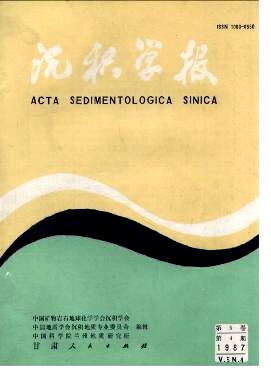DISTRIBUTION AND GEOCHEMISTRIAL CHARACTERISTICS OF TRACE METALLIC ELEMENTS IN THE OIL OF JIANGHAN SALT LAKE BASIN
- Publish Date: 1987-12-10
Abstract: By emission spectroscopy with powder sample, the trace metallic elements of 72 oil samples from Tertiary Qianjian and Xingouzui Formations of Jianhan Salt Lake Basin are systematically determined qualitatively and quantitatively. According to the analyze results, there are more than 13 trace metallic elements in the oil of Jianghan basin and they are cobalt(Co), silicon(Si), iron(Fe), germanium(Ge), zirconium(Zr), magnesium(Mg), molybdenum(Mo), lead(Pb), chromium(Cr), nickel(Ni), titanium(Ti), calcium(Ca), vanadium(V) etc. The quantitative analysis of the 13 trace metallic elements reveals that the elements content in all oil-bearing columnar sections distributes regularly both in vertical and lateral directions. Except lead and magnesium, the contents of the remaining 11 trace metallic elements increase with the increase of specific gravity, viscosity, sulphur content, asphaltene, resin, content of porphyrin compounds etc. of oil. In general, in the process of migration of oil and gas, polar component and heavy metallic elements in the petroleum can be selectively absorbed by mineral grains, which induces to decreasing these heavy components and increasing light components along the direction of petroleum migration, i.e. resulting in a regular distribution of trace metallic elements. On the basis of experimental distribution data, we can use this general regularity to judge the migration direction of petroleum in a local place. The contents of trace metallic elements of petroleum decrease with the increase of the stratum age and the petroleum maturity. It is especially worth while noting that the contents of the trace metallic elements, such as molybdenum and cobalt, in the immatured heavy oils of the first member of Qianjiang Formation(Eq) are 15 times higher than those of the underlying strata, whereas germanium is present only in the first member of Qianjiang Formation(Eq). These features are characteristics of the immatured oil of the first member of Qianjiang Formation, namely, high contents of tracing metallic elements, especially molybdenum, cobalt, germanium, chromium, nickel, vanadium, and it is an evident indication differing from the underlying oil-bearing strata. Consequently, the kinds and content variation of trace metallic elements in oil can be used to distinguish the reservoirs of different horizons and to develop reservoir correlation in new exploring regions. In the oil samples of the fourth member of Qianjiang Formation(Eq4) and Xinggouzui Formation(Ex), there are only 2 samples containing porphyrin compounds, in all the other 36 samples have been not found porphyrin compounds yet. The oil in these two formations contains nickel(4.34 ppm 0.94 ppm) generally. The metallic nickel does not combine with tetrapyrrole structure of porphyrins, but is present in a free form. Certainly, the high stratigraphic temperature and high maturity of oil may also result in the destruction of tetrapur-role structure and let metallic nickel remain there. The average V/Ni ratio of the oil in Jianghan Salt Lake Basin is 0.12. It is higher than the ratios of other oil fields of our country, such as Shengli(0.038), Gudao(0.038), Renqiou(0.047), Yumen(0.001), Kalamayi(0.029), and Baxian(0.077). But it is far lower than the V/Ni ratios of foreign marine oils,for example, 19 times less than Romashkin(2.381) of U.S.S.R, 85 times less than the oil fields(10.230) of Venezuela. This coincides with the characteristics of continental oil of our country.
| Citation: | Yang Zhiqiong, Duan Sihong. DISTRIBUTION AND GEOCHEMISTRIAL CHARACTERISTICS OF TRACE METALLIC ELEMENTS IN THE OIL OF JIANGHAN SALT LAKE BASIN[J]. Acta Sedimentologica Sinica, 1987, 5(4): 137-146. |






 DownLoad:
DownLoad: